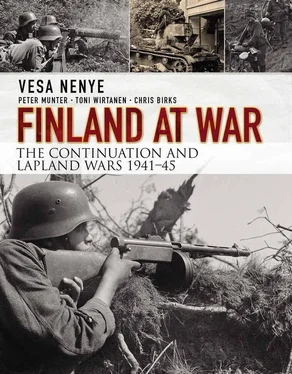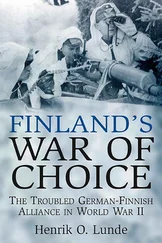Vesa Nenye
with Peter Munter, Toni Wirtanen and Chris Birks
FINLAND AT WAR
THE CONTINUATION AND LAPLAND WARS 1941-45
To our children and to future generations. Remembering those countless unsung heroes whose sacrifices paid the price of freedom.
Lapsillemme ja tuleville sukupolville. Muistaen niitä tuhansia joiden uhraukset lunastivat meille vapauden.

This rendition of Akseli Gallen-Kallela’s ‘The Defense of the Sampo’ was painted by Angelika Rasmus. It depicts Marshal Mannerheim leading the stalwart men of Finland in their defense of the Maiden of Finland against Stalin’s legions.
The dates in this section follow on directly from the signing of the Moscow Peace Treaty and the end of the Winter War, through to the end of World War II and its repercussions for Finland.
13 March
The Moscow Peace Treaty is signed. The ceasefire comes into effect at 11:00am (Finnish time), ending the Winter War. Blatantly ignoring the ceasefire, Cyril Meretskov orders the attack on Viipuri to continue until the city is in Soviet hands.
15 March
Finland’s flag is lowered at Viipuri. Troops start to withdraw behind the new borders agreed in the Moscow Peace Treaty. The Soviet Seventh Army is finally able to take the ground denied them during the war.
30 March
The Soviet Union declares that the forming of a Scandinavian defence force would be considered a hostile act.
9 April
Germany invades Denmark and Norway. May Sweden approaches Finland to propose a military alliance.
10 May
Germany invades France and the Low Countries.
22 May
Foundation of the Finland–Soviet Union Peace and Friendship Society; its secret aim is to destabilise Finland’s government.
14 June
The Finnish passenger plane Kaleva is shot down by the Soviets over Finnish territorial waters whilst returning from Estonia. German troops enter Paris.
15–16 June
The USSR demands that Lithuania, Latvia and Estonia form new governments and that they grant military access to the Red Army.
17 June
Soviet forces deploy to the Baltic states. Soon Lithuania, Latvia and Estonia ‘ask’ to become members of the USSR.
18 June
The Finnish parliament passes law for the resettlement of Karelian refugees.
22 June
France surrenders.
23 June
Rights to the Petsamo nickel deposits are demanded by the USSR.
26 June
The Soviet Union demands Bessarabia and Northern Bukovina from Romania.
27 June
The Soviet Union demands the demilitarisation of the Åland Islands. The Soviet demands presented to Romania are met in full.
29 June
Finland establishes a trade treaty with Germany.
8 July
Sweden agrees to allow German troops to pass through its territory.
8 July
The USSR demands passage to the leased Hanko Peninsula.
21 July
The Baltic states declare themselves to be Soviet republics.
22 July
First mention of Finland as a viable route of attack against the Soviet Union is recorded in the personal diary of General Franz Halder.
23 July
Finland promises to sell 60 per cent of its nickel production for the year to Germany.
24 July
Finnish Minister of Supply Väinö Tanner’s resignation is called for by the USSR.
31 July
Hitler decides to attack the Soviet Union.
4 August
The Finnish National Brothers in Arms Association is founded.
9 August
The law for the compensation of lost property for Winter War refugees is ratified.
15 August
Väinö Tanner resigns following Soviet pressure.
17 August
German Lieutenant-Colonel Josef Veltjens approaches Mannerheim to ask for permission to move German troops and supplies through Finland to northern Norway. Germany agrees to start to sell arms to Finland.
18 August
Acting President Risto Ryti instructs Mannerheim to verbally accept the German proposal of troop transport.
30 August
Germany give Romania guarantees for the nation’s safety and agree the deployment of the Wehrmacht.
6 September
Finland signs an agreement allowing Soviet passage to the leased military base at Hanko.
12 September
Finland agrees to allow passage to German troops garrisoned in Norway.
26 September
Germany begins arms shipments to Finland.
27 September
Germany, Italy and Japan sign the Tripartite Pact.
7 October
German troops enter Romania to guard its oilfields against the Soviets. In order to deceive the USSR, German soldiers are deployed among the Romanian ranks as ‘advisors’.
12 November
Soviet Minister of Foreign Affairs Vyacheslav Molotov begins his visit to Berlin. The Germans appear to dissuade the Soviets from an immediate invasion of Finland.
27 November
President Kyösti Kallio seeks permission to resign.
16–18 December
Halder and Göring meet with Major-General Paavo Talvela in Berlin.
18 December
Hitler approves the plans for Operation Barbarossa .
December
Hitler informs General Eduard Dietl of Operation Silberfuchs (Silver Fox) , a planned attack against Murmansk launched directly from Petsamo in Finland. The Finns have not yet been consulted.
19 December
Finnish President Kallio passes away.
19 December
Risto Ryti becomes President of Finland.
23 December
The Finland–Soviet Union Peace and Friendship Society is disbanded by court order in Helsinki.
3 January
The new Prime Minister of Finland, Johan Rangell, forms his cabinet.
30 January
General Erik Heinrichs meets General Halder in Berlin. The Finns refuse even to entertain talks about any hypothetical joint operations in the future.
3 March
The Soviets officially object to Germany having pressured Bulgaria to join the Axis powers.
4 March
British Operation Claymore landings against the German base at the Lofoten Islands.
7 March
Finland and Germany sign a trade agreement.
6 April
Germany invades Yugoslavia and Greece.
21 April
The Finnish long-range reconnaissance patrols (LRRP) gain official status.
25 April
Читать дальше















